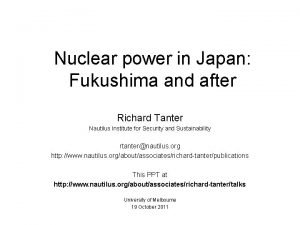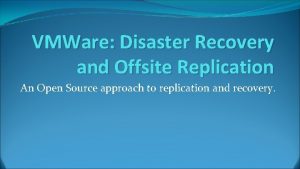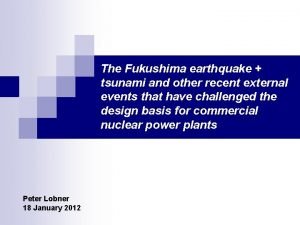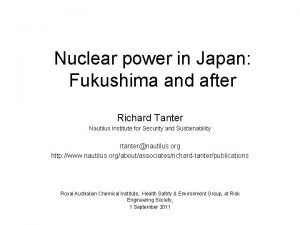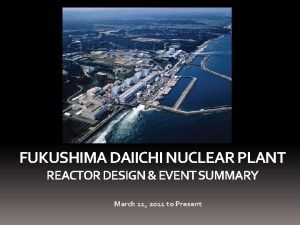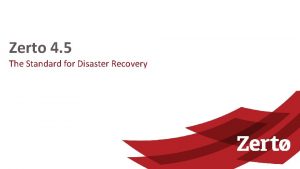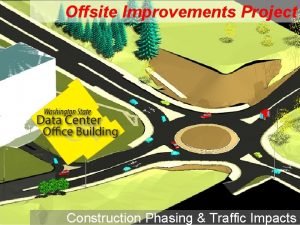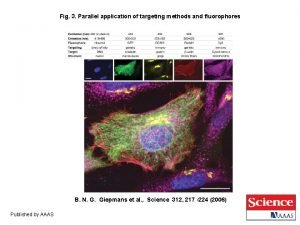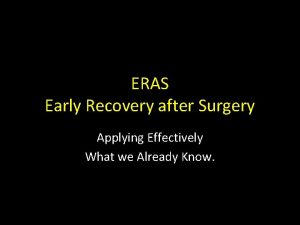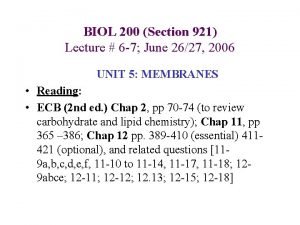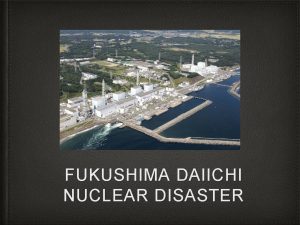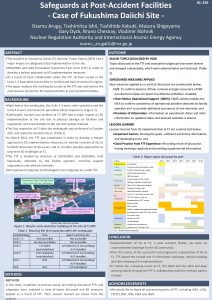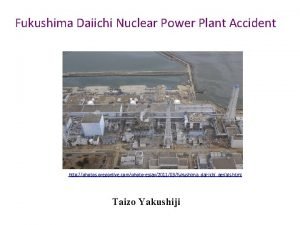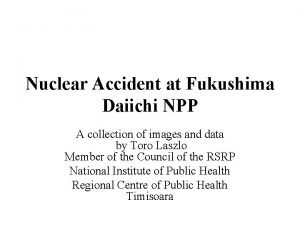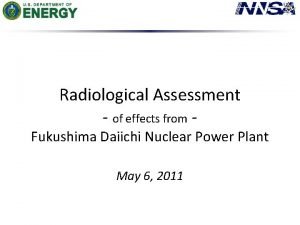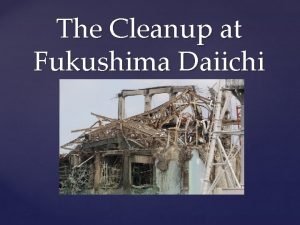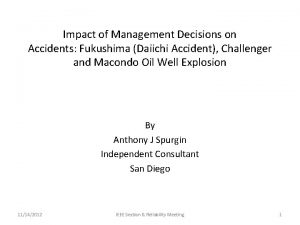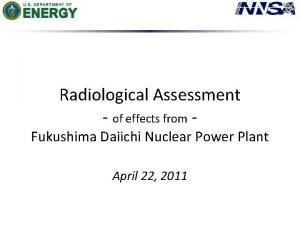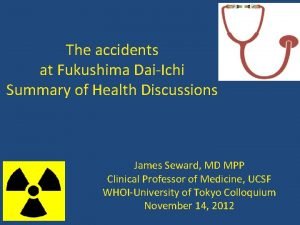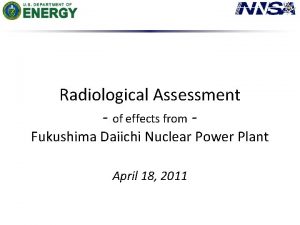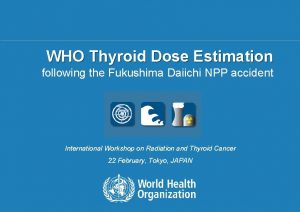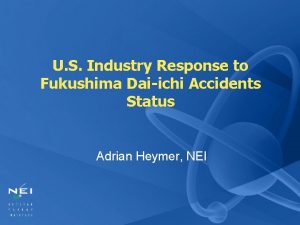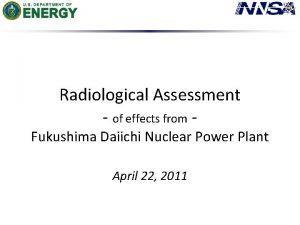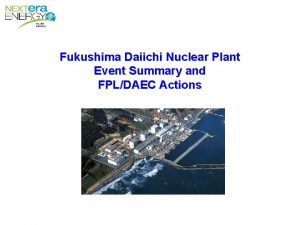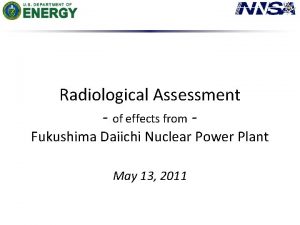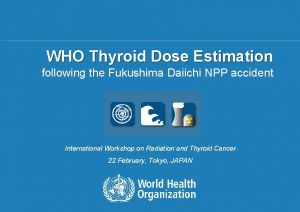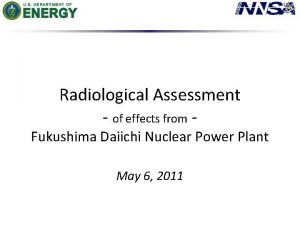Offsite postaccident recovery after the Fukushima Daiichi accident
























- Slides: 24

Off-site post-accident recovery after the Fukushima Daiichi accident: challenges and solutions B. J Howard International Conference on Challenges Faced by TSOs in Enhancing Nuclear Safety and Security, October 2014, Beijing, China

Outline • Remediation after the Fukushima accident • Estimation of doses • Setting derived reference levels • Waste generation and management • Summary

What is remediation IAEA Safety Glossary: “. . any measures that may be carried out to reduce the radiation exposure from existing contamination of land areas through actions applied to the contamination itself (the source) or to the exposure pathways to humans”. World Health Organization defines health as § “… a state of physical, mental and social well-being”.

Remediation and recovery objectives • Reduction of dose • A return to normal life and livelihoods

Principles For Remediation • Justification for undertaking remediation • Optimisation of protection through application of remedial actions • Limitation of radiation doses • Providing appropriate protection of both humans and the environment • Targeting use of resources efficiently • Ensuring open and transparent communication with stakeholders

Remediation Strategy • Sets out the means for achieving the principles and requirements set out in the national policy • Normally established by the relevant remediation implementer or by government

Remediation After The Fukushima Accident • Strategy applied in Japan includes the ICRP and IAEA dose criterion [reference level of annual additional effective dose 1 -20 m. Sv] • stepwise and rapid reduction in total doses in residential areas and farmland • Long term goal - additional annual effective dose shall be 1 m. Sv or less • Most of the dose from external dose pathways from 2012 onwards

Special Decontamination Area (SDA) § previously restricted areas § deliberate evacuation areas § additional annual effective dose for individuals anticipated >20 m. Sv during the first year § National government

Intensive Contamination Survey Area (ICSA) • additional annual effective dose between 1 -20 m. Sv estimated in some parts of the municipality • areas where air dose rate > 0. 23 µSv/h designated “Decontamination Implementation Areas”. • Municipalities

Estimation Of Doses • Estimation of additional annual effective dose to individuals used to define the designated areas for remediation were deliberately conservative and based on the concept of the critical group • an air dose rate of 0. 23 µSv/h assumed to correspond to an additional annual effective dose of 1 m. Sv.

Estimation Of Doses • ICRP /IAEA quantitatively defined the representative person as a virtual person receiving an average dose from the upper 10% of the population dose distribution • large areas of land (especially ICSA) designated for remediation where average additional annual effective doses are < 1 m. Sv from 2012 Total effective doses (m. Sv) to infants in first year UNSCEAR 2014

Challenge - Solution • Reference levels often set in emergency phase • Large uncertainty when initially estimating doses and insufficient site-specific info HIGHLY CONSERVATIVE • Develop models for the estimation of internal and external dose using country-specific data as part of emergency preparedness. • Derivation of reference levels such as air dose rates before an accident

Setting Derived Reference Levels • Many factors affect effective dose received RADIONUCLIDE, ENVIRONMENT, LAND USE, LIVING HABITS – and are site specific • Derived reference levels are a practical solution which should be site-specific and transparently derived

Identifying Key Pathways Measurement and characterisation • In post accident phase BOTH deposition density and environmental characteristics important • Most key exposure routes and areas giving higher doses will be identified quickly BUT not all LOSS OF TRUST

Preparedness Availability / use of measurement devices critical for implementing policy and strategy Koshiabura Steep forested catchments Identify radioecologically sensitive pathways / regions BEFORE an accident

Identifying, evaluating, implementing Remediation Remedial measures need to be considered for: • Effectiveness • Feasibility • Practicality • Costs • Wastes • Side effects • Social aspects • Experience

TEMPLATE Name of measure Objective Specifying the aims of the action, e. g. , reassurance, dose reduction Other Benefits Secondary objectives e. g. social implications Countermeasure description Short description of what the countermeasure is. Target On or to what target do you apply this countermeasure? Targeted radionuclides Caesium, strontium, mixed deposit, Plutonium, Americium Scale of application Contamination pathway Large? Small? Generally applicable? Exposure pathway Time of application Ingestion? Inhalation? External? root uptake, contaminated feed/standing water, re-suspension, plant- animal, irrigation Time after deposition (early – up to 6 weeks, medium – up to 2 years, late – more than two years), season, need for repetition

Constraints: Required safety precautions Communication costs Legal constraints Other limitations Compensation costs Social constraints Waste: Waste cost Environmental constraints Amount and type Assumptions Communication constraints Possible transport, treatment and storage routes. Cost-effectiveness: Factors influencing waste issues Ethical considerations Effectiveness: Countermeasure effectiveness Factors influencing effectiveness of procedure (Technical) Factors influencing effectiveness of procedure (social) Feasibility: Doses: Averted dose • Factors influencing averted dose Required specific equipment Additional dose Required ancillary equipment Intervention costs: Required utilities and infrastructure Equipment Consumables Required consumables Operator time Required skills • Factors influencing costs Side-effect evaluation: Environmental impact Agricultural impact Social impact Other side effects, pos. or neg. Stakeholder opinion Practical experience Key references Comments

Relevance?

Pilot demonstration projects Residential Area Farmland 5, 00 6, 00 0, 00 3. 8 ~ 9. 5 ~ 14. 3 > 14. 3 DSa Factor 4, 00 2, 00 0, 00 3. 8 ~ 9. 5 Dose before decontamination (µSv/h) > 14. 3 Dose before decontamination (µSv/h) Roads Forest 4, 00 2, 00 1, 50 2, 00 1, 00 0, 00 3. 8 ~ 9. 5 ~ 14. 3 > 14. 3 Dose before decontamination (µSv/h) DSa Factor 9. 5 ~ 14. 3 0, 50 0, 00 3. 8 ~ 9. 5 ~ 14. 3 > 14. 3 Dose before decontamination (µSv/h) MOE Decontamination Model Evaluation Project in six SDA 3 sites

Relevance?

Waste Generation and Management Decontamination of surfaces and topsoil • reduces external exposure • High acceptability and feasibility • Protects economic value of residences and land • Well received by residents High logistical needs Large generation of waste High cost Averted dose less than air dose reduction at 1 m • Averted dose can be small • •

Waste generation and management Prior thought to regulatory, management and practical application issues relevant to waste • Generation • Minimisation • Incineration • Disposal • Cost

Summary • Broad objectives of remediation need to be addressed • Site specific • Emergency preparedness needs to include the post accident phase / remediation • Need to retain knowledge and expertise, and promote knowledge transfer from countries with practical experience • Revise international guidance
 Elephants foot
Elephants foot Vmware offsite disaster recovery
Vmware offsite disaster recovery After me after me after me
After me after me after me John 14
John 14 Flooding barriers
Flooding barriers Fukushima nuclear flowers imgur
Fukushima nuclear flowers imgur Fukushima
Fukushima Corium
Corium Fukushima
Fukushima Fukushima reactor design
Fukushima reactor design Zerto offsite clone
Zerto offsite clone Offsite improvements
Offsite improvements After kato's serious motorcycle accident
After kato's serious motorcycle accident Flip frap
Flip frap Early recovery after surgery
Early recovery after surgery Fluorescence recovery after photobleaching
Fluorescence recovery after photobleaching Thang điểm glasgow
Thang điểm glasgow ưu thế lai là gì
ưu thế lai là gì Thẻ vin
Thẻ vin Tư thế ngồi viết
Tư thế ngồi viết Cái miệng bé xinh thế chỉ nói điều hay thôi
Cái miệng bé xinh thế chỉ nói điều hay thôi Các châu lục và đại dương trên thế giới
Các châu lục và đại dương trên thế giới Bổ thể
Bổ thể Từ ngữ thể hiện lòng nhân hậu
Từ ngữ thể hiện lòng nhân hậu Tư thế ngồi viết
Tư thế ngồi viết
